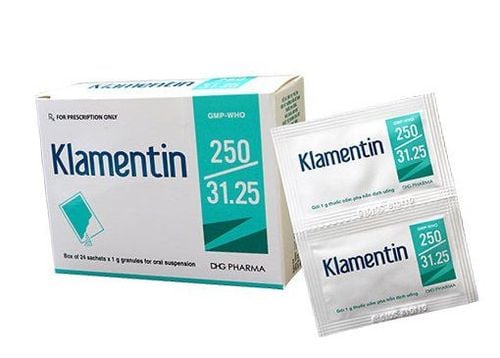This is an automatically translated article.
Vigentin DT is a combination antibiotic between amoxicillin and clavulanic acid with the strength ratios Vigentin 875 mg / 125 mg, 500 mg / 125 mg, 500 mg / 62.5 mg, 250 mg / 62.5 mg. In this article, we would like to introduce in detail about Vigentin 875/125 DT.
1. What is Vigentin?
Vigentin 875/125 drugs are classified into drug groups: Antiparasitic, anti-infective, antiviral, antifungal drugs. Vigentin 875/125 DT is made in the form of tablets.
Ingredients in each tablet: Amoxicillin (as Amoxicillin trihydrate) 875 mg; Clavulanic acid (in the form of Potassium clavulanate + microcrystalline cellulose 1:1) 125 mg
Vigentin 875/125 DT is a product of TW1 Pharmaceutical Company - Vietnam
2. What are the uses of Vigentin 875/125 DT?
Amoxicillin in Vigentin is an aminopenicillin, stable in acidic media, with a broader spectrum of action than benzylpenicillin. The drug has a more special effect that is against gram-negative bacilli. Similar to other penicillins, amoxicillin has a bactericidal effect, due to the inhibition of mucopeptide biosynthesis of the bacterial cell wall. Amoxicillin is active against most gram-negative and gram-positive bacteria, such as streptococci, non-penicillinase-producing staphylococci, Diplococcus pneumoniae, H. influenzae, N.gonorrheae, E.coli, and proteus mirabilis. Amoxicillin is inactive against penicillinase-producing bacteria such as methicillin-resistant staphylococci, all strains of Pseudomonas and most strains of Klebsiella and Enterobarter.
Vigentin 875/125 DT is usually indicated in cases of short-term bacterial infections as follows:
Upper respiratory tract infections such as otitis media, sinusitis, tonsillitis. Lower respiratory tract infections caused by strains of bacteria Branhamella catarrhalis, H. influenzae producing beta-lactamase: acute and chronic bronchitis, pneumonia. Severe infections of the urogenital tract due to beta-lactamase-producing strains of E. coli, Klebsiella and Enterobacter: urethritis, pyelonephritis, cystitis. Skin and soft tissue infections: common are boils, abscesses, wound infections. Bone and joint infections such as osteomyelitis. A common dental infection is an alveolar abscess. Other infections: infections caused by miscarriage, abortion. Patients should note that the above information is for reference only, Vigentin is only used when prescribed by a doctor.
Do not use Vigentin in the following cases:
People with penicillin allergy, cross allergy to cephalosporins, allergy to beta-lactam antibiotics Patients with infectious mononucleosis or leukemia lymphocytes. Patients with a history of jaundice, liver dysfunction due to use of amoxicillin and clavulanate or penicillins because clavulanic acid has the potential to increase intrahepatic cholestasis.
3. Dosage - How to take Vigentin 875/125 DT
Patients need to take Vigentin 875/125 DT at the beginning of food to minimize drug intolerance in the gastrointestinal tract. Do not use Vigentin continuously for more than 14 days without testing and re-evaluating treatment methods.
For the film-coated tablet form, the patient should take the tablet whole with a glass of water and do not break, chew, crush or crush the tablet.
The dose of Vigentin prescribed by the doctor in each case may be different. Recommended dosage is calculated according to the composition of amoxicillin as follows:
Dosage for adults & children > 12 years old and over 40 kg: 500 - 625 mg x 3 times/day or 1000 mg x 2 times/day. Children under 40 kg from 2-12 years old: With tablets: 30 - 60 mg/kg/day, children < 2 years old: 30 - 40 mg/kg/day, divided into several times 8 hours apart. Reduce dose in patients with hepatic & renal impairment. Dosage adjustment of Vigentin in patients with renal impairment: Creatinine clearance (ClCr) > 30ml/min: no need to change dose.
ClCr 15–30ml/min: use the usual dose every 12–18 hours.
ClCr from 5–15ml/min: use the usual dose every 20–36 hours.
ClCr less than 5ml/min: usual dose given 48 hours apart.
If the patient is on hemodialysis, the oral dose is 1 tablet of 500 mg (according to the content of amoxicillin) between each time of dialysis and an additional 500 mg tablet after each dialysis.
It has been noted that an overdose of Vigentin is less likely to cause complications because the drug is well tolerated even at high doses. However, some acute reactions may still occur during the use of the drug depending on the hypersensitivity of the individual patient. In the event of an overdose of the drug causing serious symptoms, immediately go to the nearest medical facility or call the emergency number.
If the patient misses a dose, take it as soon as you remember it. But if it is almost time to remember the missed dose, skip the missed dose and take your next dose at the scheduled time. Patients should not take a double dose to make up for a missed dose.
4. Drug interactions
Vigentin medicine increases or decreases the effect of some drugs when used together such as: anticoagulants (such as heparin), Allopurinol, probenecid, oral contraceptives are hormones. Food, alcohol and tobacco can interact with some drugs, so in the process of using Vigentin, it is necessary to consult with your doctor, pharmacist.
5. Side effects when using Vigentin
At normal doses, side effects may occur in about 5% of users, including:
Common: gastrointestinal upset, diarrhea, rash, itching. Uncommon: erythema, rash, nausea, vomiting, eosinophilia, hepatitis, cholestatic jaundice, increased transaminases (may be severe and persist for several months). Rare: anaphylactic reactions, Stevens-Johnson syndrome, erythema multiforme, Quincke's edema, toxic epidermal necrolysis, pseudomembranous colitis, hemolytic anemia, interstitial nephritis, pruritus, urticaria, fever & arthralgia, neuro-angioedema. In the process of using the drug, the patient should note that if you encounter any unwanted effects that adversely affect health and life, stop taking the drug and immediately notify the treating doctor.
6. Safe drug use
Caution should be exercised when using Vigentin for patients with atopy, allergic rhinitis, bronchial asthma, and urticaria. Patients with manifestations of liver dysfunction, moderate or severe renal impairment should use this drug with caution. When used in patients with a history of amoxicillin use with erythema associated with fever, lymphadenopathy. Use caution when using the drug for a long time because it can promote the development of resistant bacteria. There are not many reports on the use of Vigentin in pregnant women, so it should be avoided in pregnant women for at least the first 3 months, unless absolutely prescribed by a doctor. Generally, the drug is not harmful to a nursing infant. However, it is possible that the infant is at risk of hypersensitivity to very small amounts of the drug in breast milk. Vigentin can be used by women who are breastfeeding. Vigentin should be stored in a dry place, below 30oC, away from direct light. Keep Vigentin out of the reach of children.
Please dial HOTLINE for more information or register for an appointment HERE. Download MyVinmec app to make appointments faster and to manage your bookings easily.













